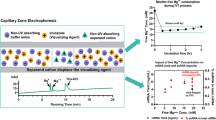Abstract
A method of ELISA for measuring the binding of different samples of immunoglobulin (IgG) and its fragments to human plasminogen (Pg) has been developed. Instead of plasminogen, the heavy chain of plasminogen (Pg-H) containing five ligand-binding kringle domains, immobilized on the surface of the plate, was used in this method as a detector. It was found that IgG treated with plasmin (IgGPm-t) binds to the immobilized Pg-H 2.84 times more strongly than intact IgG. Both IgG samples showed a weak nonspecific binding to the immobilized light chain of plasminogen (Pg-L). It was shown that 0.2 M L-lysine inhibits the binding of IgGPm-t and does not affect the nonspecific binding of intact IgG to the immobilized Pg-H, indicating the involvement of lysine-binding regions of Pg-H in binding to IgGPm-t. A preliminary treatment of IgG samples with carboxypeptidase В (CPB) inhibited the binding of IgGPm-t and did not affect the nonspecific binding of intact IgG to the immobilized Pg-H, which indicates a key role of the С-terminal lysine of IgGPm-t in the specific binding to the lysine-binding sites of Pg. The study of the effects of intact IgG and IgGPm-t on the rate of activation of Glu- and Lys-forms of Pg (Glu-Pg and Lys-Pg) by a tissue activator of Pg (tPA) and urokinase (uPA) in buffer showed that intact IgG completely inhibited the activation of Glu-Pg and Lys-Pg with both tPA and uPA. Presumably, the inhibitory effect of intact IgG is due to steric hindrances that it creates for protein–protein interactions of the activators with the zymogen. IgGPm-t accelerated the generation of plasmin from Pg. In this case, the stimulatory effect of IgGPm-t on the activation of Glu-Pg under the action of tPA was ∼25% higher than on the activation of Lys-Pg, which is explained by more significant conformational changes in the Glu-Pg molecule compared with the Lys-Pg molecule after their binding to IgGPm-t. The results suggest that the specific cleavage of IgG by plasmin may be one of the ways by which the plasminogen/plasmin system is involved in various physiological and pathological processes.
Similar content being viewed by others
Abbreviations
- Alb:
-
human albumin
- AlbPm-t :
-
human albumin treated with plasmin
- 6-AHA:
-
6-aminohexanoic acid
- uPA:
-
two-chain urokinase
- IgG:
-
immunoglobulin G
- IgGPm-t :
-
IgG treated with plasmin
- CPB:
-
carboxypeptidase В
- K:
-
kringle domain
- LBS:
-
lysine-binding site
- Pm:
-
plasmin
- Pg:
-
plasminogen
- Glu-Pg and Lys-Pg:
-
Glu- and Lys-forms of plasminogen
- NTP:
-
N-terminal peptide
- tPA:
-
tissue activator of plasminogen
- Pg-H and Pg-L:
-
the heavy and light chains of plasmin(ogen)
References
Ponting, C.P., Marshall, J.M., and Cederholm-Williams, S.A., Blood Coagul. Fibrinolysis, 1992, vol. 3, pp. 605–614.
Aisina, R.B. and Mukhametova, L.I., Russ. J. Bioorg. Chem., 2014, vol. 40, pp. 590–605.
Thorsen, S., Clemmensen, I., Sottrup Jensen, L., and Magnusson, S., Biochim. Biophys. Acta, 1981, vol. 668, pp. 377–387.
Miles, L.A. and Parmer, R.J., Semin. Thromb. Hemost., 2013, vol. 39, pp. 329–337.
Rijken, D.C. and Sakharov, D.V., Thromb. Res., 2001, vol. 103, pp. 41–49.
Castellino, F.J. and Ploplis, V.A., Thromb. Haemost., 2005, vol. 93, pp. 647–654.
Ogiwara, K., Nogami, K., Nishiya, K., and Shima, M., Blood Coagul. Fibrinolysis, 2010, vol. 21, pp. 568–576.
Pryzdial, E.L., Lavigne, N., Dupuis, N., and Kessler, G.E., J. Biol. Chem., 1999, vol. 274, pp. 8500–8505.
Waisman, D.M., Plasminogen: Structure, Activation and Regulation, Waisman, D.M., Ed., New York: Springer, Kluwer Academic/Plenum Publishers, 2003.
Santala, A., Saarinen, J., Kovanen, P., and Kuusela, P., FEBS Lett., 1999, vol. 461, pp. 153–156.
Law, R.H.P., Abu-Ssaydeh, D., and Whisstock, C., Curr. Opin. Struct. Biol., 2013, vol. 23, pp. 836–841.
Wiman, B. and Collen, D., Nature, 1978, vol. 272, pp. 549–550.
Radcliffe, R. and Heinze, T., Arch. Biochem. Biophys., 1981, vol. 211, pp. 750–761.
Machovich, R. and Owen, W., Arch. Biochem. Biophys., 1977, vol. 344, pp. 343–349.
Harpel, P.C., Sullivan, R., and Chang, T.-S., J. Biol. Chem., 1989, vol. 264, pp. 616–624.
Dano, K., Behrendt, N., Hoyer-Hansen, G., Johnsen, M., Lund, L.R., Ploug, M., and Romer, J., Thromb. Haemost., 2005, vol. 93, pp. 676–681.
Brezski, R.J. and Jordan, R.E., BioScience, 2010, vol. 2, pp. 212–220.
Gonzalez-Gronow, M., Cuchacovich, M., Grigg, D.M., and Pizzo, S.V., J. Mol. Med., 1996, vol. 74, pp. 463–469.
Stefanescu, M., Szegli, G., Cremer, L., Zarma, L., Mazilu, E., Naghiu, M., Niculescu, D., Gaches, A., and Onu, A., Arch. Roum. Pathol. Exp. Microbiol., 1989, vol. 48, pp. 47–53.
Kozmin, Ya.D., Bliznyukov, O.P., Martynov, A.I., and Alekberova, Z.S., Immunologiya, 2004, vol. 25, pp. 56–62.
Goufman, E.I., Yakovlev, V.N., Tikhonova, N.B., Aisina, R.B., Yarygin, K.N., Mukhametova, L.I., Gershkovich, K.B., and Gulin, D.A., Bull. Experim. Biol. Med., 2015, vol. 158, pp. 493–496.
Law, R.H., Caradoc-Davies, T., Cowieson, N., Horvath, A.J., Quek, A.J., et al., Cell Rep., 2012, vol. 1, pp. 185–190.
Levashov, M.Yu., Aisina, R.B., Gershkovich, K.B., and Varfolomeyev, S.D., Biochemistry (Moscow), 2007, vol. 72, pp. 707–715.
Laemmly, U.K., Nature, 1970, vol. 227, pp. 680–685.
Aisina, R.B., Mukhametova, L.I., Gulin, D.A., Levashov, M.Y., Prisyazhnaya, N.V., Gershkovich, K.B., and Varfolomeyev, S.D., Biochemistry (Moscow), 2009, vol. 74, pp. 1104–1113.
Author information
Authors and Affiliations
Corresponding author
Additional information
Original Russian Text © R.B. Aisina, L.I. Mukhametova, K.B. Gershkovich, V.N. Yakovlev, E.I. Goufman, N.B. Tikhonova, 2018, published in Bioorganicheskaya Khimiya, 2018, Vol. 44, No. 2, pp. 194–202.
Rights and permissions
About this article
Cite this article
Aisina, R.B., Mukhametova, L.I., Gershkovich, K.B. et al. Effect of Specific Cleavage of Immunoglobulin G by Plasmin on the Binding and Activation of Plasminogen. Russ J Bioorg Chem 44, 210–216 (2018). https://doi.org/10.1134/S1068162018010028
Received:
Accepted:
Published:
Issue Date:
DOI: https://doi.org/10.1134/S1068162018010028




